Effects of Dissolved Organic Matter (DOM) on Perfluorooctanoic Acid (PFOA) in a Seagoing River—A Case Study of the Wanggang River Flowing into the East China Sea
Abstract
1. Introduction
2. Materials and Methods
2.1. Study Area and Sample Collection
2.2. Measurement of PFOA Content in the Water
2.3. Quality Assurance and Quality Control (QA/QC)
2.4. DOM Measurement
2.5. Data Processing
3. Results and Discussion
3.1. Profiles of PFOA in the Wanggang River
3.2. DOM Concentration and Distribution
3.3. Relationship between DOM and PFOA
3.4. Outlook on Further Studies
4. Conclusions
Author Contributions
Funding
Data Availability Statement
Acknowledgments
Conflicts of Interest
References
- Xu, R.; Tao, W.; Lin, H.; Huang, D.; Su, P.; Gao, P.; Sun, X.; Yang, Z.; Sun, W. Effects of Perfluorooctanoic Acid (PFOA) and Perfluorooctane Sulfonic Acid (PFOS) on Soil Microbial Community. Microb. Ecol. 2022, 83, 929–941. [Google Scholar] [CrossRef] [PubMed]
- Hua, Z.; Yu, L.; Liu, X.; Zhang, Y.; Ma, Y.; Lu, Y.; Wang, Y.; Yang, Y.; Xue, H. Perfluoroalkyl acids in surface sediments from the lower Yangtze River: Occurrence, distribution, sources, inventory, and risk assessment. Sci. Total Environ. 2021, 798, 149332. [Google Scholar] [CrossRef] [PubMed]
- Liu, Y.; Zhang, Y.; Li, J.; Wu, N.; Li, W.; Niu, Z. Distribution, partitioning behavior and positive matrix factorization-based source analysis of legacy and emerging polyfluorinated alkyl substances in the dissolved phase, surface sediment and suspended particulate matter around coastal areas of Bohai Bay, China. Environ. Pollut. 2019, 246, 34–44. [Google Scholar] [CrossRef] [PubMed]
- Yao, Y.; Chang, S.; Zhao, Y.; Tang, J.; Sun, H.; Xie, Z. Per- and poly-fluoroalkyl substances (PFASs) in the urban, industrial, and background atmosphere of Northeastern China coast around the Bohai Sea: Occurrence, partitioning, and seasonal variation. Atmos. Environ. 2017, 167, 150–158. [Google Scholar] [CrossRef]
- Dauchy, X.; Boiteux, V.; Colin, A.; Bach, C.; Rosin, C.; Munoz, J.-F. Poly- and Perfluoroalkyl Substances in Runoff Water and Wastewater Sampled at a Firefighter Training Area. Arch. Environ. Contam. Toxicol. 2019, 76, 206–215. [Google Scholar] [CrossRef]
- Wang, P.; Lu, Y.; Wang, T.; Zhu, Z.; Li, Q.; Zhang, Y.; Fu, Y.; Xiao, Y.; Giesy, J.P. Transport of short-chain perfluoroalkyl acids from concentrated fluoropolymer facilities to the Daling River estuary, China. Environ. Sci. Pollut. Res. 2015, 22, 9626–9636. [Google Scholar] [CrossRef]
- Ololade, I.A.; Oladoja, N.A.; Ololade, O.O.; Oloye, F.F.; Adeola, A.; Alabi, A.B.; Ademila, O.; Adanigbo, P.; Owolabi, M.B. Geographical distribution of perfluorooctanesulfonate and perfluorooctanoate in selected rivers from Nigeria. J. Environ. Chem. Eng. 2018, 6, 4061–4069. [Google Scholar] [CrossRef]
- Bao, Y.; Li, B.; Xie, S.; Huang, J. Vertical profiles of microbial communities in perfluoroalkyl substance-contaminated soils. Ann. Microbiol. 2018, 68, 399–408. [Google Scholar] [CrossRef]
- Han, D.; Ma, Y.; Huang, C.; Zhang, X.; Xu, H.; Zhou, Y.; Liang, S.; Chen, X.; Huang, X.; Liao, H.; et al. Occurrence and source apportionment of perfluoroalkyl acids (PFAAs) in the atmosphere in China. Atmos. Chem. Phys. 2019, 19, 14107–14117. [Google Scholar] [CrossRef]
- Wang, Q.-W.; Yang, G.-P.; Zhang, Z.-M.; Jian, S. Perfluoroalkyl acids in surface sediments of the East China Sea. Environ. Pollut. 2017, 231, 59–67. [Google Scholar] [CrossRef]
- Miranda, D.A.; Benskin, J.P.; Awad, R.; Lepoint, G.; Leonel, J.; Hatje, V. Bioaccumulation of Per- and polyfluoroalkyl substances (PFASs) in a tropical estuarine food web. Sci. Total Environ. 2021, 754, 142146. [Google Scholar] [CrossRef] [PubMed]
- Wang, Y.; Shi, Y.; Vestergren, R.; Zhou, Z.; Liang, Y.; Cai, Y. Using hair, nail and urine samples for human exposure assessment of legacy and emerging per- and polyfluoroalkyl substances. Sci. Total Environ. 2018, 636, 383–391. [Google Scholar] [CrossRef] [PubMed]
- Wang, Z.; Han, R.; Muhammad, A.; Guan, D.-X.; Zama, E.; Li, G. Correlative distribution of DOM and heavy metals in the soils of the Zhangxi watershed in Ningbo city, East of China. Environ. Pollut. 2022, 299, 118811. [Google Scholar] [CrossRef] [PubMed]
- Yao, X.; Zhang, Y.; Zhu, G.; Qin, B.; Feng, L.; Cai, L.; Gao, G. Resolving the variability of CDOM fluorescence to differentiate the sources and fate of DOM in Lake Taihu and its tributaries. Chemosphere 2011, 82, 145–155. [Google Scholar] [CrossRef]
- Williams, C.J.; Frost, P.C.; Morales-Williams, A.M.; Larson, J.H.; Richardson, W.B.; Chiandet, A.S.; Xenopoulos, M.A. Human activities cause distinct dissolved organic matter composition across freshwater ecosystems. Glob. Chang. Biol. 2016, 22, 613–626. [Google Scholar] [CrossRef]
- Liu, W.-X.; He, W.; Wu, J.-Y.; Wu, W.-J.; Xu, F.-L. Effects of fluorescent dissolved organic matters (FDOMs) on perfluoroalkyl acids (PFAAs) in lake and river water. Sci. Total Environ. 2019, 666, 598–607. [Google Scholar] [CrossRef]
- Shang, J.; Chen, J.; Shen, Z.; Xiao, X.; Yang, H.; Wang, Y.; Ruan, A. Photochemical degradation of PAHs in estuarine surface water: Effects of DOM, salinity, and suspended particulate matter. Environ. Sci. Pollut. Res. 2015, 22, 12374–12383. [Google Scholar] [CrossRef]
- Ma, L.; Yates, S.R. Dissolved organic matter and estrogen interactions regulate estrogen removal in the aqueous environment: A review. Sci. Total Environ. 2018, 640–641, 529–542. [Google Scholar] [CrossRef]
- Wen, W.; Xia, X.; Chen, X.; Wang, H.; Zhu, B.; Li, H.; Li, Y. Bioconcentration of perfluoroalkyl substances by Chironomus plumosus larvae in water with different types of dissolved organic matters. Environ. Pollut. 2016, 213, 299–307. [Google Scholar] [CrossRef]
- Wang, S.; Wang, H.; Deng, W. Perfluorooctane sulfonate (PFOS) distribution and effect factors in the water and sediment of the Yellow River Estuary, China. Environ. Monit. Assess. 2013, 185, 8517–8524. [Google Scholar] [CrossRef]
- Wang, S.; Cai, Y.; Ma, L.; Lin, X.; Li, Q.; Li, Y.; Wang, X. Perfluoroalkyl substances in water, sediment, and fish from a subtropical river of China: Environmental behaviors and potential risk. Chemosphere 2022, 288, 132513. [Google Scholar] [CrossRef] [PubMed]
- Ma, J.; Pei, D.; Zhang, X.; Lai, Q.; He, F.; Fu, C.; Liu, J.; Li, W. The Distribution of DOM in the Wanggang River Flowing into the East China Sea. Int. J. Environ. Res. Public Health 2022, 19, 9219. [Google Scholar] [CrossRef] [PubMed]
- Gong, X.; Yang, C.; Hong, Y.; Chung, A.C.; Cai, Z. PFOA and PFOS promote diabetic renal injury in vitro by impairing the metabolisms of amino acids and purines. Sci. Total Environ. 2019, 676, 72–86. [Google Scholar] [CrossRef] [PubMed]
- Nebbioso, A.; Piccolo, A. Molecular characterization of dissolved organic matter (DOM): A critical review. Anal. Bioanal. Chem. 2012, 405, 109–124. [Google Scholar] [CrossRef] [PubMed]
- Gao, L.; Liu, J.; Bao, K.; Chen, N.; Meng, B. Multicompartment occurrence and partitioning of alternative and legacy per- and polyfluoroalkyl substances in an impacted river in China. Sci. Total Environ. 2020, 729, 138753. [Google Scholar] [CrossRef]
- Chen, M.; Wang, Q.; Shan, G.; Zhu, L.; Yang, L.; Liu, M. Occurrence, partitioning and bioaccumulation of emerging and legacy per- and polyfluoroalkyl substances in Taihu Lake, China. Sci. Total Environ. 2018, 634, 251–259. [Google Scholar] [CrossRef]
- Tang, A.; Zhang, X.; Li, R.; Tu, W.; Guo, H.; Zhang, Y.; Li, Z.; Liu, Y.; Mai, B. Spatiotemporal distribution, partitioning behavior and flux of per- and polyfluoroalkyl substances in surface water and sediment from Poyang Lake, China. Chemosphere 2022, 295, 133855. [Google Scholar] [CrossRef]
- Guo, R.; Liu, X.; Liu, J.; Liu, Y.; Qiao, X.; Ma, M.; Zheng, B.; Zhao, X. Occurrence, partition and environmental risk assessment of per- and polyfluoroalkyl substances in water and sediment from the Baiyangdian Lake, China. Sci. Rep. 2020, 10, 4691. [Google Scholar] [CrossRef]
- Meng, L.; Song, B.; Zhong, H.; Ma, X.; Wang, Y.; Ma, D.; Lu, Y.; Gao, W.; Wang, Y.; Jiang, G. Legacy and emerging per- and polyfluoroalkyl substances (PFAS) in the Bohai Sea and its inflow rivers. Environ. Int. 2021, 156, 106735. [Google Scholar] [CrossRef]
- Liu, W.-X.; He, W.; Qin, N.; Kong, X.-Z.; He, Q.-S.; Yang, B.; Yang, C.; Jorgensen, S.E.; Xu, F.-L. Temporal-spatial distributions and ecological risks of perfluoroalkyl acids (PFAAs) in the surface water from the fifth-largest freshwater lake in China (Lake Chaohu). Environ. Pollut. 2015, 200, 24–34. [Google Scholar] [CrossRef]
- Glüge, J.; Scheringer, M.; Cousins, I.T.; DeWitt, J.C.; Goldenman, G.; Herzke, D.; Lohmann, R.; Ng, C.A.; Trier, X.; Wang, Z. An overview of the uses of per- and polyfluoroalkyl substances (PFAS). Environ. Sci. Process. Impacts 2020, 22, 2345–2373. [Google Scholar] [CrossRef] [PubMed]
- Paul, A.G.; Jones, K.C.; Sweetman, A. A First Global Production, Emission, And Environmental Inventory For Perfluorooctane Sulfonate. Environ. Sci. Technol. 2009, 43, 386–392. [Google Scholar] [CrossRef]
- Xu, H.; Guo, L. Molecular size-dependent abundance and composition of dissolved organic matter in river, lake and sea waters. Water Res. 2017, 117, 115–126. [Google Scholar] [CrossRef] [PubMed]
- Zhou, Y.; Jeppesen, E.; Zhang, Y.; Niu, C.; Shi, K.; Liu, X.; Zhu, G.; Qin, B. Chromophoric dissolved organic matter of black waters in a highly eutrophic Chinese lake: Freshly produced from algal scums? J. Hazard. Mater. 2015, 299, 222–230. [Google Scholar] [CrossRef] [PubMed]
- Chen, X.; Xia, X.; Wang, X.; Qiao, J.; Chen, H. A comparative study on sorption of perfluorooctane sulfonate (PFOS) by chars, ash and carbon nanotubes. Chemosphere 2011, 83, 1313–1319. [Google Scholar] [CrossRef] [PubMed]
- Xia, X.; Dai, Z.; Rabearisoa, A.H.; Zhao, P.; Jiang, X. Comparing humic substance and protein compound effects on the bioaccumulation of perfluoroalkyl substances by Daphnia magna in water. Chemosphere 2015, 119, 978–986. [Google Scholar] [CrossRef] [PubMed]
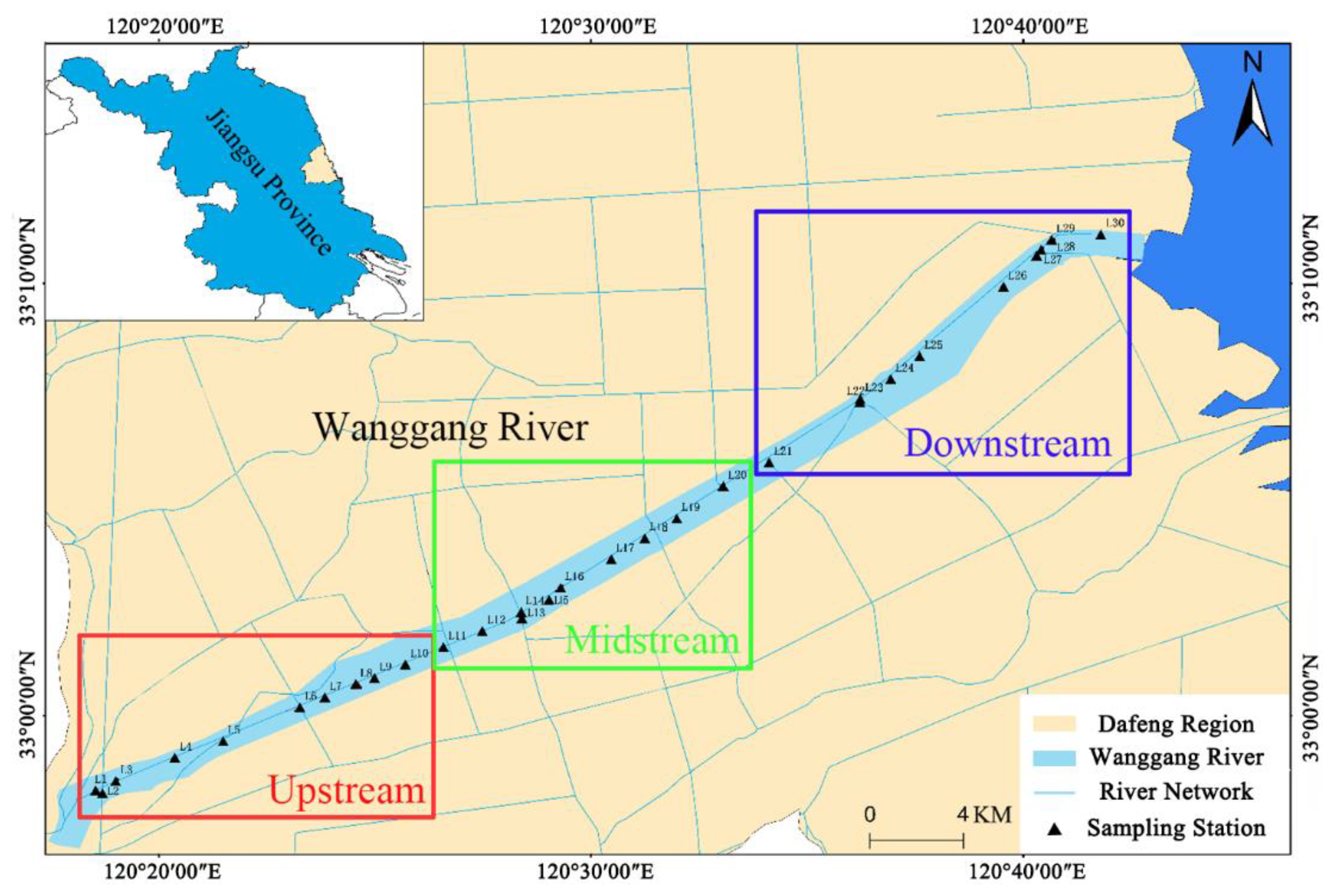
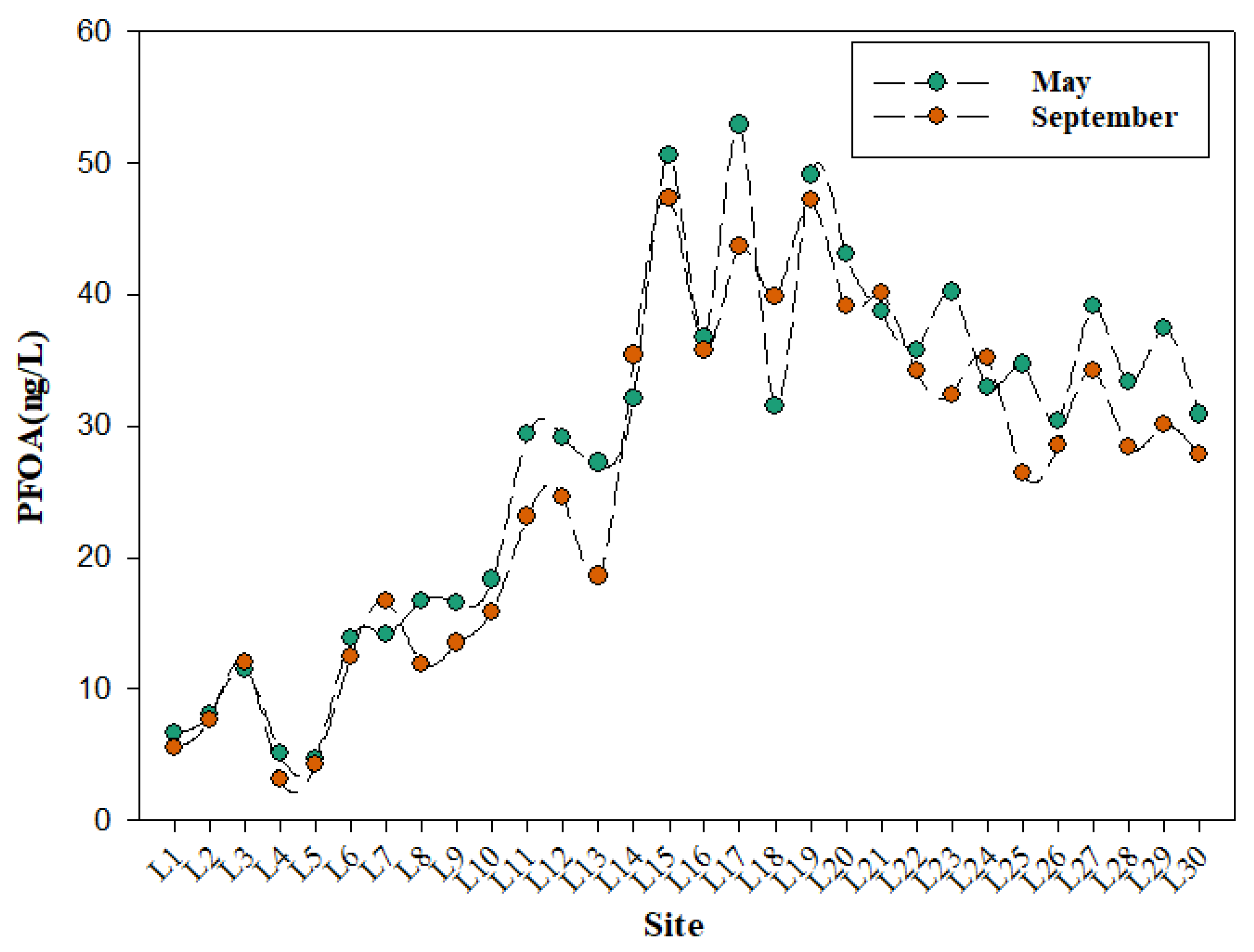
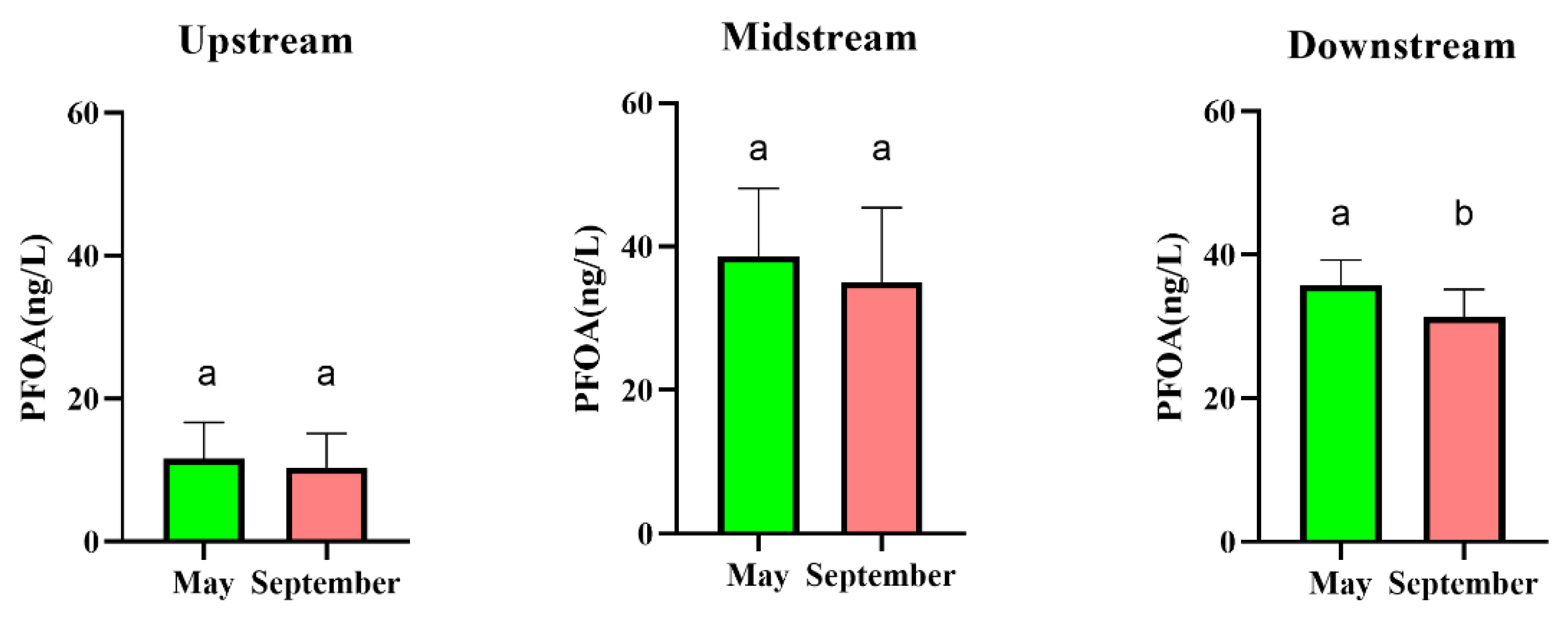
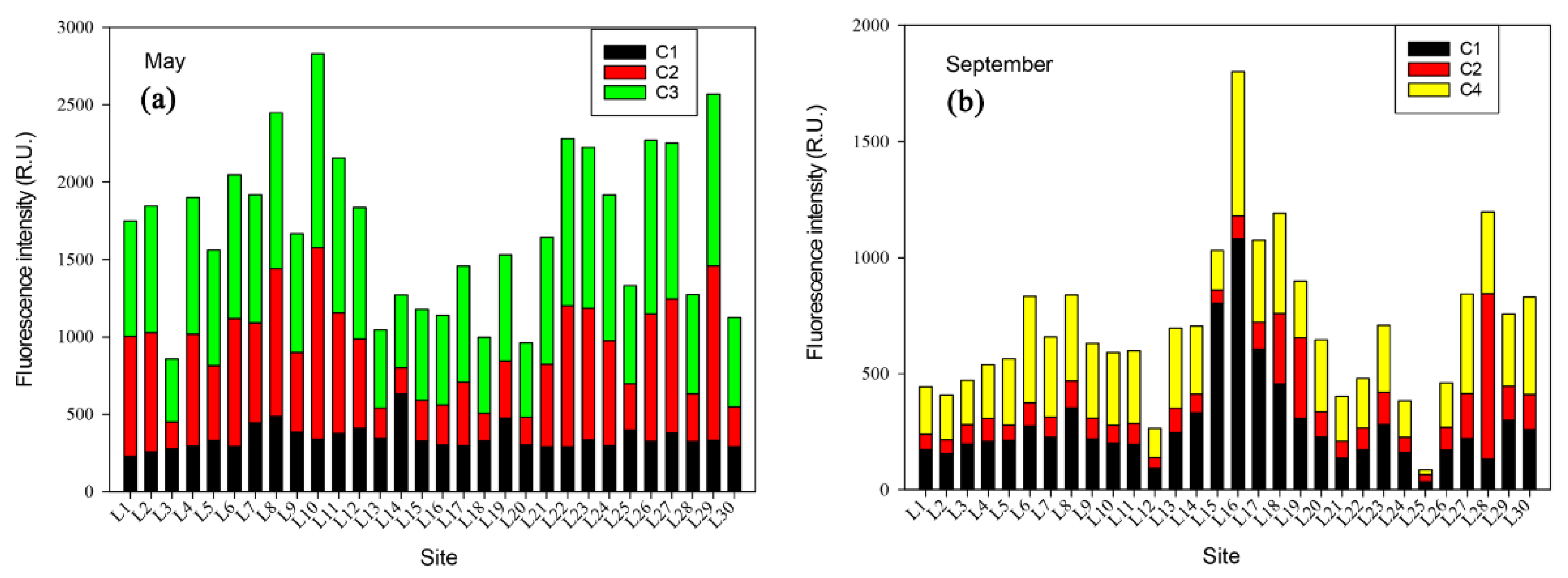
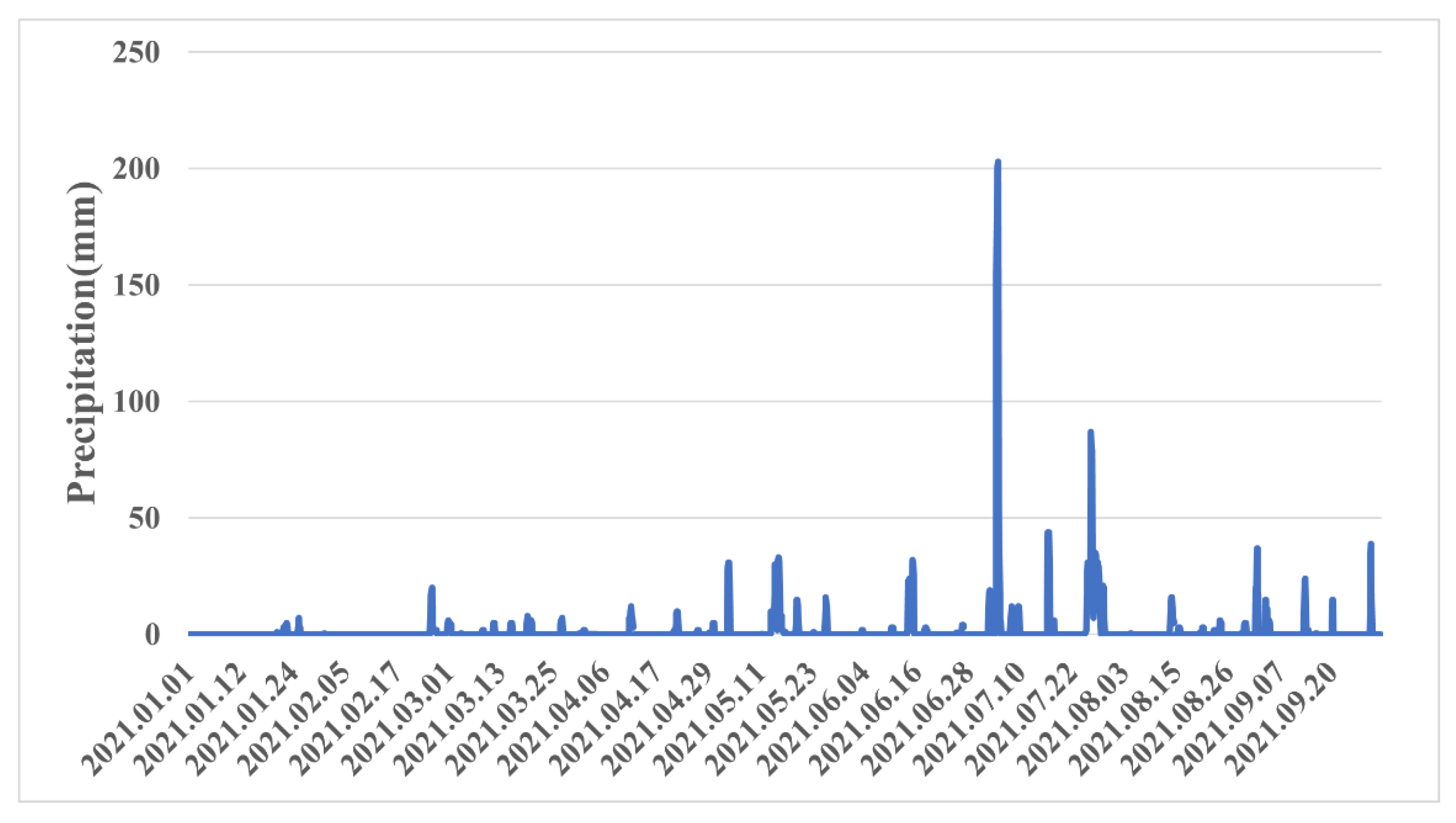
| Time (min) | A (%) | B (%) | Flow Rate (mL·min−1) |
|---|---|---|---|
| 0.00 | 80 | 20 | 0.4 |
| 14.00 | 10 | 90 | 0.4 |
| 16.00 | 10 | 90 | 0.4 |
| 16.01 | 80 | 20 | 0.4 |
| 20.00 | 80 | 20 | 0.4 |
| Study Area | Date | Range (ng·L−1) | References |
|---|---|---|---|
| Wanggang River | 2021 | 3.2–52.9 | This study |
| Daling River | 2018 | 6.5–37.9 | [25] |
| Jiulong River | 2014–2015 | 5.5–15 | [21] |
| Yangtze River | 2019 | 8.9–3.6 | [2] |
| Taihu Lake | 2019 | 16.9–39.7 | [26] |
| Poyang Lake | 2016 | 1.8–17 | [27] |
| Baiyangdian Lake | 2016 | 13.6–441 | [28] |
| Pearl River | 2019 | 0.125–1030 | [29] |
| C1 | C2 | C4 | DOC | PFOA | |
|---|---|---|---|---|---|
| C1 | 0.564 ** | 0.658 ** | 0.081 | 0.364 * | |
| C2 | 0.015 | 0.740 ** | 0.150 | 0.254 | |
| C3 | 0.088 | 0.955 ** | 0.128 | 0.041 | |
| DOC | 0.075 | 0.182 | 0.254 | 0.194 | |
| PFOA | 0.126 | 0.141 | 0.046 | 0.182 |
Publisher’s Note: MDPI stays neutral with regard to jurisdictional claims in published maps and institutional affiliations. |
© 2022 by the authors. Licensee MDPI, Basel, Switzerland. This article is an open access article distributed under the terms and conditions of the Creative Commons Attribution (CC BY) license (https://creativecommons.org/licenses/by/4.0/).
Share and Cite
Lai, Q.; Shui, J.; Ma, J.; He, F.; Wang, L.; Peng, F.; Zhu, X.; Pang, Q.; Wang, Y. Effects of Dissolved Organic Matter (DOM) on Perfluorooctanoic Acid (PFOA) in a Seagoing River—A Case Study of the Wanggang River Flowing into the East China Sea. Water 2022, 14, 3580. https://doi.org/10.3390/w14213580
Lai Q, Shui J, Ma J, He F, Wang L, Peng F, Zhu X, Pang Q, Wang Y. Effects of Dissolved Organic Matter (DOM) on Perfluorooctanoic Acid (PFOA) in a Seagoing River—A Case Study of the Wanggang River Flowing into the East China Sea. Water. 2022; 14(21):3580. https://doi.org/10.3390/w14213580
Chicago/Turabian StyleLai, Qiuying, Jian Shui, Jie Ma, Fei He, Longmian Wang, Fuquan Peng, Xiang Zhu, Qingqing Pang, and Yuao Wang. 2022. "Effects of Dissolved Organic Matter (DOM) on Perfluorooctanoic Acid (PFOA) in a Seagoing River—A Case Study of the Wanggang River Flowing into the East China Sea" Water 14, no. 21: 3580. https://doi.org/10.3390/w14213580
APA StyleLai, Q., Shui, J., Ma, J., He, F., Wang, L., Peng, F., Zhu, X., Pang, Q., & Wang, Y. (2022). Effects of Dissolved Organic Matter (DOM) on Perfluorooctanoic Acid (PFOA) in a Seagoing River—A Case Study of the Wanggang River Flowing into the East China Sea. Water, 14(21), 3580. https://doi.org/10.3390/w14213580







